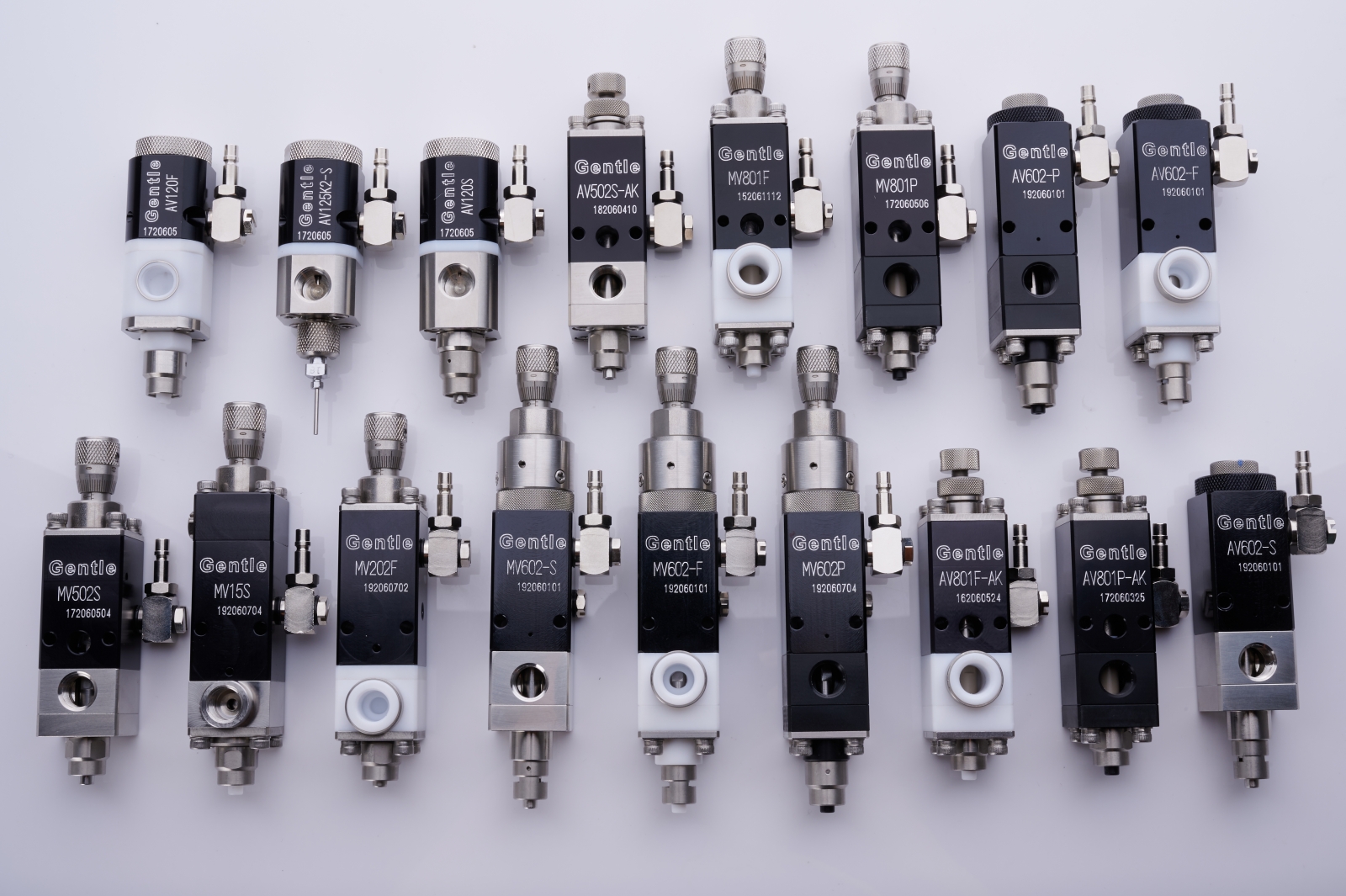What is a Liquid Dispensing Valve? A Complete Guide to Choosing the Best Brand & Specifications!
What exactly is a liquid dispensing valve, and how do you choose the right one for your needs? In manufacturing, precise fluid control is essential for ensuring product quality and production safety. Liquid dispensing valves play a key role in meeting these high standards. This article will walk you through the types, functions, and selection process of liquid dispensing valves, giving you the tools you need to make an informed purchase decision.
Table of Contents
What is a Liquid Dispensing Valve & Its Purpose?
A liquid dispensing valve, also referred to as a dispensing valve, is designed to dispense, fill, or coat various types of materials, including liquids and adhesives. At GENTLE, we offer three main types of liquid dispensing valves: diaphragm valves, needle valves, and poppet valves. The choice of valve depends on the application, fluid characteristics, and the specific needs of your workpiece.
- Function: Liquid dispensing valves are industrial devices that precisely control the flow of chemicals, ensuring safety and reliability throughout the production process.
- Materials: These valves are made from highly resistant materials like fluoropolymers (PFA, PTFE) and stainless steel, designed to withstand harsh environments, prevent leakage, and ensure fluid integrity.
- Advantages: Know for their excellent chemical resistance and precision, liquid dispensing valves are indispensable in modern manufacturing, providing high levels of accuracy and reliability.

Types of liquid dispensing valves: diaphragm, needle, and poppet valve.
Applications of Liquid Dispensing Valves
- Chemical Industry: These valves provide precise flow control when handling corrosive or toxic chemicals, helping to prevent leaks and reducing environmental and safety risks.
- Pharmaceutical & Biotech: During drug production, precise liquid dispensing is critical. Liquid dispensing valves help control the flow of reagents and active ingredients, ensuring consistent dosage and product quality.
- Semiconductor Manufacturing: In semiconductor production, where ultra-pure water and chemicals are essential, these valves ensure the accurate delivery of liquids, preventing contamination and maintaining product purity.
- Food Processing: Used to regulate the flow of ingredients like cleaning agents, additives, and flavorings, liquid dispensing valves ensure hygienic and safe conditions throughout the production process.
Liquid Dispensing Valve Specifications
Material Selection: The valve material plays a crucial role in determining chemical resistance and mechanical strength. Common materials include PTFE, stainless steel (SUS304, 316), PEEK, and polypropylene. Choose based on the corrosiveness of the fluid and environmental conditions.
Types of Operation: Liquid dispensing valves can be manual, pneumatic, or electric, depending on the fluid type and operational requirements.
- Diaphragm Valves: Ideal for adjustable, high-frequency dispensing, suitable for low to medium viscosity fluids.
- Needle Valves: Great for single-component liquids, commonly used for micro-dispensing in low to high viscosity materials.
- Poppet Valves: Used in applications requiring backflow prevention, suitable for a wide range of fluids, particularly low to medium viscosity liquids.
4 Essential Tips for Choosing the Right Liquid Dispensing Valve Brand
- Research Brand Reputation: Look for brands with a strong reputation in the market. Customer reviews and case studies can give you insights into the reliability and quality of the product.
- Understand the Brand's Area of Expertise: Different brands specialize in various fields. Choose a brand with expertise in your application area to ensure you receive the best technical support and product options.
- Compare After-Sales Support: High-quality after-sales support ensures that the product performs well throughout its lifecycle. A brand with solid customer service can provide valuable support in case of issues or questions.
- Check Industry Case Studies: Review the brand's success stories and customer feedback to gauge how well their products meet industry needs.
5 Key Considerations When Using Liquid Dispensing Valves
- Follow Installation Instructions: Always install valves according to the manufacturer's guidelines to avoid damage or leaks.
- Regular Inspection & Maintenance: Periodically check and maintain valves, especially in corrosive environments, to ensure they are functioning properly and replace worn parts as needed.
- Avoid Overpressure: Operate valves within their specified pressure range. Overpressure can lead to valve damage and pose safety risks.
- Correct Wetted Part Materials: Select the appropriate materials for the wetted part to ensure long-term stability and prevent contamination.
- Maintain a Clean Working Environment: Keep the working area clean to avoid introducing dust or other contaminants into the valve, which could affect its operation.
Conclusion
The selection of the right liquid dispensing valve is essential for safety, efficiency, and precision across industries such as chemicals, pharmaceuticals, and semiconductors. Understanding the various specifications, applications, and brands will help you choose the best valve for your production needs. GENTLE's liquid dispensing valves provide high-performance solutions with precision control, ensuring smooth operations and superior product quality.
Further Reading:
How to Use a Dispensing Machine? Key Tips, Sequence, and Precautions!
Choosing the Right Pneumatic Fitting: Nut, Push-In, or Barbed? Here's What You Need to Know